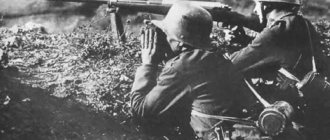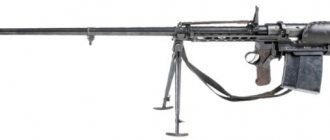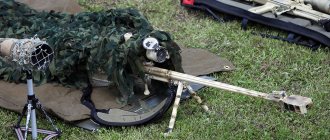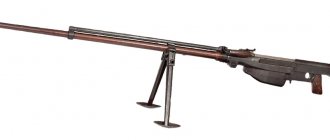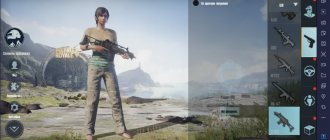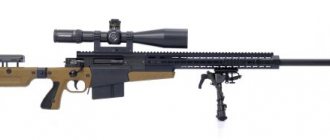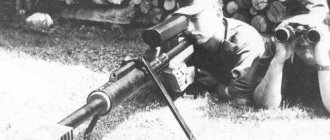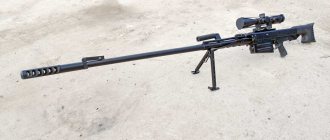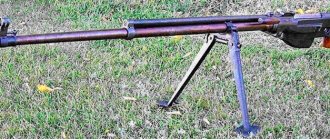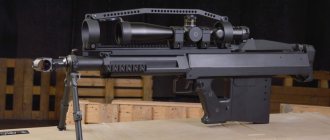Finnish semi-automatic anti-tank rifle
| This article requires additional links for verification . |
Type of Semi-automatic anti-tank rifle
| Lahti L-39 | |
| Anti-tank rifle Lahti L-39. | |
| Type | Semi-automatic anti-tank rifle |
| Place of origin | Finland |
| Service history | |
| Used | Finland |
| Wars | Winter War Continuation of the War |
| Production history | |
| Developed | 1939 |
| Manufacturer | Valtion Kivääritehdas (VKT) |
| No built | ~ 1,906 |
| Options | L-39/44 anti-aircraft |
| Characteristics | |
| Weight | 49.5 kg (109 lb) |
| Length | 2200 mm (87 in) |
| Barrel length | 51.2 inches (1300 mm) |
| Cartridge | 20 × 138 mmB |
| Caliber | 20 mm (0.79 in) |
| Action | Gas |
| Rate of fire | Maximum. 30 minutes |
| starting speed | 800 m/s (2600 ft/s) |
| Feeding system | 10-round box magazine |
Lahti L-39
is a Finnish 20 mm anti-tank rifle used during World War II. It had excellent accuracy, range and range, but its size made it difficult to transport. It was nicknamed "Norsupissi" ("Elephant Gun"), and since tanks had armor too thick for Lahti to penetrate, its use switched to long-range sniping, tank pursuit and with the fully automatic L-39 variant /44, use as a homemade anti-aircraft gun.
Content:
In the 1930s, the Finnish military looked with great apprehension towards its large eastern neighbor. From the reports of the attache, intelligence, and simply from the media, it followed that there were many, and then very many, Soviet tanks. Of course, by the standards of that time, the Soviet-Finnish border was not the most convenient place for the massive use of tanks. However, this was not the English Channel to relax and calmly look at photos from parades or the next “big maneuvers”. I had to think about how to solve this problem, taking into account the modest capabilities available.
Self-taught artisan without a motor
Like many outstanding gunsmiths of the 20th century, in the biography of Aimo Lahti it is very difficult to find traces of any special design education. As a child, Lahti did not like to study and barely completed only six grades of primary school, after which at the age of 13 he got a job at the Viyala glass factory (the village of Viyala is now part of the city of Akaa. - Ed.). But he had an interest in weapons - as opposed to studying - since childhood.
With his first salary of five marks, Lahti bought an old Berdan rifle and made acquaintance with a local blacksmith, Juho Sater, who, among other things, repaired weapons. As a result, Lahti decided that a career as a glazier was all for his wife,” and before being drafted into the army, he changed several more jobs, from the railway to a power plant.
But in the young Finnish army, Aimo’s habit of tinkering with all sorts of shooting pieces of iron turned out to be very appropriate. Having started his service as a private, Lahti was soon sent to officer courses with a weaponry focus and in 1921 he became a gunsmith in a reserve regiment stationed in central Finland.
Aimo Lahti
By this time, the Finnish army, with the help of German teachers, became acquainted with some of the latest models of small arms - in particular with the Maschinenpistole 18/I submachine gun.
The first prototype, created by him in 1922 with the help of Juho, was chambered for a weak 7.65x17 mm pistol cartridge and was more of an idea demonstrator than a real weapon. Neither this nor the next example aroused interest in the Finnish Ministry of Defense. Lahti managed to convince only a few officers of his own regiment of the prospect of his brainchild. In 1924, they threw their hats around and created JSC Konepistooli Osakeyhtiö.
As Finnish historians delicately write: The new company had a lot of inspiration, but very little finance.” The shareholders had to wait quite a long time for profits, until finally, in 1931, the Tikkakoski company bought the rights to the next model of the submachine gun, which eventually became known as the Suomi M / 31.
Finnish soldier with a Suomi submachine gun"
Post-war period[ | ]
Quite a large number of Lahti L-39s ended up in the United States of America after the war. In many regions of this country, where the sale of small arms does not contradict local laws, there are only restrictions on magazine capacity and barrel length. Moreover, restrictions on barrel length apply only to compact weapons, and not to a rifle with a barrel length of 1.3 meters, because in general such legislation is aimed at limiting the concealed carrying of powerful weapons. The exception is pistols and revolvers, which are not subject to restrictions on barrel length[1].
The magazine capacity of civilian weapons is limited to 10 rounds, which is quite consistent with the characteristics of the Lahti L-39. The only restriction the gun was subject to was the caliber restriction. Therefore, the Lahti L-39s were rearranged to use the .50 BMG cartridge. The original version chambered in 20x138mm is illegal in many states. In other words, in the USA it is impossible to be the legal owner of a full-fledged assault rifle, but it is quite possible to become the owner of a Lahti L-39 anti-tank rifle, with the full right to use it to protect your life, health and property[1].
| Small arms of Finland during the Winter and Second World Wars | ||
| Pistols |
| |
| Rifles |
| |
| Submachine guns |
| |
| Machine guns |
| |
| Anti-tank weapons | ||
| Anti-tank and anti-personnel mines |
| |
Combat use
The Lahti L-39 proved effective in combat operations on the Soviet-Finnish front. Taking advantage of the difficult terrain conditions, the Finns staged successful ambushes on Soviet troops. It allowed such maneuverable groups to fight lightly armored Soviet armored vehicles. The L-39 was a relatively portable weapon that the Finns put to good use besides shooting at armored vehicles. The 20mm high-explosive round worked well against bunkers and trucks.
In addition, this anti-tank rifle was also used as an anti-sniper weapon. The dummy of a Finnish army officer was positioned so that the Soviet sniper could see it. The sniper fired a shot, unmasking his position, at which a shot was fired from the Lahti L-39.
During the second Soviet-Finnish War, the Lahti L-39 was no longer effective against Soviet medium tanks T-34 and heavy KV-1, but the anti-tank rifle was successfully used against various field fortifications and embrasures. Later, a number of guns were adapted as light anti-aircraft guns.
Development[edit]
Aimo Lahti doubted the original idea of a 13 mm anti-tank machine gun and began working on a 20 mm design. Officers who required smaller caliber anti-tank weapons believed that the muzzle velocity of 20 mm rounds was insufficient to penetrate armor and that weapons with a higher rate of fire and smaller caliber would prove useful. As a result, Lahti developed two competing anti-tank weapons: a 13.2 mm machine gun and a 20 mm rifle. After test-firing both guns in 1939, they found that the 20mm rifle provided better armor penetration.
Operation[edit]
The rifle is a gas-powered semi-automatic weapon with a piston located under the barrel and feeding ammunition from a removable top magazine with bottom ejection of spent cartridges. To reduce recoil, the rifle is equipped with a five-hole muzzle brake and a soft leather recoil pad. The barrel has a wooden casing to allow it to be transported after the shot has caused the barrel to heat up.
Finnish soldiers carry a Lahti VKT L-39 20mm anti-tank rifle over a railway embankment.
Although the Finns “lost the first production Lahti PTRs in battle” back in 1941, the PTRs only reached the Soviet rifle range in the summer of ’44, when during the Vyborg-Petrozavodsk operation the Finns lost more than 300 Lahti L-39s - very it was inconvenient to run away with him from the advancing “thirty-four”.
Already at the first stage, while examining the operation of the PTR automation, the range officers noted the similarity of individual components with samples already known to them. Thus, the system of the rod with the piston, located at the bottom, and being a separate part from the frame, vividly reminded them of the SVT and PTRS, and the locking system reminded them of the Czech ZB-30 light machine gun and the Japanese handbrake of 1922.
Along with the PTR, they also carefully examined the four cartridges captured with it. At the same time, cartridges marked BPD were identified as Italian, by analogy with previously captured ammunition for an Italian machine gun. Indeed, these were shells manufactured by the Italian company Bombrini, Parodi & Delfino. In fact, there were even two types of Italian shells - the SMI marking stood for Società Metallurgica Italiana, but in 1944, the test site employees had problems with Internet access. Finally, another shell, also unidentified at the test site, was actually a native Finnish one, manufactured by Tikkakoski Ammunition Co. Interestingly, the German-made steel case caused problems with extraction, but the Finnish brass PTR fired without any problems.
But regardless of the place of birth, the anti-tank capabilities of 20 mm armor-piercing weapons left much to be desired. When firing at 30 mm armor plates, reliable penetrations were obtained no further than 175 meters. This, in general, was not enough for the 41st, not to mention the 44th. As the testers noted, the poor penetration results were caused by both the low initial velocity of the projectile and the quality of the steel body, which was inferior in hardness even to the cores of domestic 14.5 mm B-32 armor-piercing bullets. Let us recall that the B-32s were intended for light targets; against tanks there were 14.5 mm B-41s with a cermet core made of tungsten carbide. Therefore, although the final conclusion noted some potentially interesting design features of Aimo Lahti’s creation, the testers’ conclusion was quite skeptical.
“In general, the design of weapons is not of interest to domestic weapons technology
Individual components and mechanisms of the gun are structurally original to some extent and can attract the attention of domestic designers, from the point of view of the approach to resolving individual design issues of a particular component or mechanism
In terms of its maneuverability, the Finnish anti-tank rifle of the 1939 model is significantly lower, weighing more than the PTRD, 2.86 times and 2.56 times more than the PTRS. In terms of dimensions, the Finnish PTR of the 1939 model is also inferior to the domestic PTRD and PTRS rifles.
In terms of combat qualities, the Finnish anti-tank rifle of the 1939 model is significantly lower than the domestic PTRD and PTRS rifles and provides approximately two times less armor penetration. Thus, a Finnish gun penetrates armor 30 mm thick only from a distance of no more than 175 m (when firing armor-piercing incendiary-tracer shells), while domestic PTRD and PTRS guns penetrate the same armor from a range of about 300–350 m.”
Heavy anti-tank rifle Lahti 20 pst.kiv 39 / VKT L-39 / Norsupyssy
| 20 pst.kiv 39 (Lahti L-39) |
At the end of the 1930s, Finnish gunsmiths received the task of creating an anti-tank rifle (ATR). And already in mid-1939, the famous designer Aimo Johannes Lahti presented a heavy anti-tank rifle of his own design.
Lahti L-39
In September 1939, the large-caliber Lahti anti-tank rifle was adopted by the Finnish army with the official designation “20 pst.kiv 39” (20 panssarintorjuntakivaaru 39 - 20-mm anti-tank rifle of the 1939 model). Later this gun became known with the designation L-39 (Lahti-39), and in the army it received the unofficial name “Norsupyssy” (elephant gun).
The first prototypes of this weapon were created for the original 20-mm cartridge developed by Aimo Lahti himself, but the Lahti L-39 anti-tank rifle entered mass production, designed for the German 20x138 mm cartridge from the FlaK 30 and FlaK 38 anti-aircraft guns purchased by Finland in Germany. At the same time, German ammunition provided a wider range of types of projectiles - armor-piercing, incendiary, high-explosive fragmentation, etc.
Heavy large-caliber anti-tank rifle Lahti L-39 self-loading. The automation is built on the principle of removing powder gases through a transverse hole in the barrel with a short stroke of the gas piston, which transfers most of its kinetic energy to massive moving parts: the bolt frame and the combat cylinder.
Lahti L-39 with used ammunition
The gas chamber is a closed type, with a 4-position gas regulator and a guide tube, located under the barrel. The gas exhaust mechanism has an adjustable hole diameter of 1.5 - 1.8 - 2.2 - 2.5 mm, designed to ensure stable operation of the weapon in any climatic conditions and with any contamination of the parts and mechanisms of the weapon.
The bolt is connected to the receiver by a vertically moving wedge. Locking and unlocking is carried out by protrusions of the bolt frame, made separately from the rod with the piston. The bolt contains a firing pin with a mainspring, an ejector and a rammer.
The weapon is fed with ammunition from detachable box magazines with a double-row arrangement of cartridges with a capacity of 5 or 10 pieces, or a drum magazine with a capacity of 15 pieces. To reduce the overall weight of the system, loaded magazines are transported in a special closure and therefore the magazine window of the receiver is equipped with a protective cover to prevent contamination of the moving parts during transportation.
| 1 – muzzle brake; 2 – wooden casing; 3 – store; 4 – charging handle; 5 – butt plate; 6 – bipod; 7 – skis; 8 – magazine latch; 9 – butt plate closure; 10 – shoulder rest latch; 11 – rack. |
The magazine receiver is located on top of the weapon. Behind the magazine, also on top, there is a magazine latch. The magazine latch is also the latch of the protective cover. When the latch is pressed, the lid automatically opens under the influence of a special spring.
sector sight Lahti L-39
The upper location of the magazine left its mark on the design of many mechanisms. Thus, in the combat cylinder, the forwarding protrusions, with the help of which cartridges are fed from the magazine into the chamber, are located in the upper part. Accordingly, the ejector is located in the lower part of the cylinder, and the reflection of the cartridge case is carried out downwards using a reflector rigidly fixed in the receiver. To change the trajectory of the reflected cartridge case in order to prevent injury to the shooter, a rubber roller shock absorber had to be introduced into the design, located in front of the trigger guard. A kind of guard between the trigger guard and the pistol grip is designed to protect the shooter’s hand when reflected cartridges bounce off the ground.
view of the receiver and sight of the Lahti L-39
Also, due to the upper location of the magazine, it was necessary to shift the mechanical sight to the left, which, however, led to a positive result - the excess of the aiming line above the barrel is very slight. Sights consist of a front sight on the barrel and a sector sight on the receiver with range settings from 100 to 1400 meters.
However, the main technical difficulties had to be solved when designing the trigger mechanism, the kinematic chain of which passes through two moving parts: the bolt frame and the combat cylinder, in the cavity of which a spring-loaded firing pin is placed. The peculiarities of the location of the striker were the reason for the “frame” design of the locking wedge and the upper sear, which ensured the longitudinal movement of the striker in the cavity of the combat cylinder.
Lahti L-39 controls
In addition, the gun was equipped with two trigger mechanisms: a rear one for holding the moving system cocked and a front one for holding the firing pin. The front trigger mechanism operates only when the moving system is in the extreme forward position and the bolt is completely locked. The rear trigger mechanism provides more intensive barrel cooling, holding the moving system in the rear position after each shot. The front trigger mechanism allowed only single fire.
On the left side of the weapon, near the pistol grip, there is a safety box. When engaged, it locks the front trigger release lever.
Lahti L-39 controls
The moving parts of the automation move inside the milled receiver, each along its own guides.
The barrel is connected to the receiver with a nut. A cylindrical wooden casing with perforation is placed on the barrel, secured with a split spring nut. The same thread is used to attach the muzzle brake.
The five-chamber muzzle brake (has 5 transverse holes) is made of a single blank and is coated with matte chrome to prevent rusting. Due to the transverse arrangement of the chamber openings, the effectiveness of the muzzle brake is not very high - about 40%. This is explained by the fact that their inclined arrangement, which increases the reactive component of the recoil braking, would lead to an intolerable acoustic load on the second crew number - the loader. A protective casing is attached to the base of the muzzle brake using a clamp and chain.
muzzle brake Lahti L-39 A
butt plate with a buffer and a return spring guide is attached to the rear of the receiver using a pin removed from the right side. The butt plate with a perforated (to soften recoil) rubber pad moves vertically in the grooves of the butt plate. The butt is secured in the desired vertical position with a spring-loaded button.
The spring buffer serves to soften the impact of moving parts in the rearmost position and accumulate recoil energy to provide more energetic roll-up in order to increase the stability of the automation in various conditions.
view of the butt plate of the Lahti L-39.
A wooden cheek pad is attached to the left side of the receiver using screws.
On the right side of the receiver there is a mechanism for cocking the moving parts, consisting of a progressively moving rack (which with its tooth moves the bolt frame with the combat cylinder back), a handle with a lock and a gear.
The gun is mounted on a carriage consisting of transport skis made of plywood and lined with brass sheets, designed for shooting from soft soils and moving the system over short distances when changing firing positions, and a bipod with openers for shooting from hard soil.
view of the butt plate and cheek rest of Lahti L-39
The bipod is fixed in horizontal and vertical positions using two spring-loaded pin clamps. When moving the bipod from one position to another, you need to pull out one latch, rotate the bipod to a certain angle, pull out the second latch, tighten the bipod and release the latch, locking it in the desired position.
The interaction of the parts and mechanisms of the gun occurs as follows. To load, you need to open the dustproof cover of the magazine window, attach the magazine and, having pressed the charging handle, turn it away from you until it stops (about 2 turns); return the handle to its original position (otherwise, when the moving parts are lowered, it will rotate under the influence of the return spring). The moving parts remain in the rearmost position during the delay. The weapon is loaded.
To fire a shot, it is necessary to move the safety catch back and, grasping the pistol grip, press the button, while the delay, lowering, releases the moving parts, the movement of which forward sends the shot into the chamber, locks the barrel bore and aligns the position of the trigger mechanism parts.
skis with bipod Lahti L-39
When you press the trigger, a shot occurs. After the bullet passes through the gas outlet hole, the gas piston pushes the bolt frame with the combat cylinder back. In this case, the bolt is unlocked by the bevel of the protrusion of the frame, the ejector removes the spent cartridge case, it is reflected outside the receiver, and the firing pin is cocked by the protrusion of the ridge of the frame. The moving parts roll back to their rearmost position and, if the pistol grip key was released before pressing the trigger, they stop at the delay at the beginning of the roll. The purpose of the delay is to eliminate the temperature effect of the heated barrel on the projectile fuse during breaks in firing. When firing a small number of shots, the key is pressed constantly. In this case, the moving parts return to the extreme forward position, sending the next shot into the chamber, locking the bevel of the frame, acting on the bevel of the wedge, moving it upward. The wedge, falling into a special recess in the receiver, locks the barrel bore. Upon reaching the extreme forward position of the bolt frame, the downward part of the pusher moves the lower sear forward, compressing its spring. The kinematic connection of the trigger mechanism parts is broken and the shot does not occur. To fire the next shot, you must release the trigger and squeeze it again.
Lahti L-39 crew
The PTR crew consisted of two people: a gunner and a loader.
The Lahti L-39 anti-tank rifle was used by the Finnish army during the Winter War of 1939-1940. with the USSR and later during the Second World War. It was initially used to fight lightly armored tanks and self-propelled guns and showed its best performance in the fight against Soviet T-26 and BT-7 tanks. But by 1941, its armor penetration (at a range of 100 m it penetrated 30 mm armor at an angle of 90 degrees) became insufficient and the gun began to be used mainly for suppressing firing points, fortifications and shooting at aircraft. In addition, this anti-tank rifle was also used as an anti-sniper weapon.
The wide range of ammunition used, including fragmentation and incendiary shells, made it possible to use anti-tank rifles to destroy advancing infantry (the target could be hit by shrapnel at a distance of up to 2.5 m from the place where the shell exploded) and create fires behind enemy lines.
| Caliber, mm | 20x138 |
| Length, mm | 2240 |
| Barrel length, mm | 1300 |
| Weight without cartridges, kg | 49.5 |
| Store, count. cartridges | 5, 10, 15 |
| Rate of fire, rds/min | 30 |
| Sighting range, m | 1400 |
| Initial bullet speed, m/s | 825 |
| Armor penetration, (distance/meeting angle/penetration) | 100 m / 90o / 30 mm 300 m / 90o / 25 mm |
In the army, the gun proved to be an extremely accurate weapon and was issued only to the best shooters who had undergone special training. The combat losses of the L-39 in the Great Patriotic War are also small and do not exceed 30%, which indicates both sufficient (even with the weight with ammunition) maneuverability and a careful attitude towards anti-tank missiles.
The Lahti L-39 anti-tank rifle was mass-produced at the Finnish State Armory (VKT) from 1939 to 1944. A total of 1906 PTRs were produced.
In 1944, on the basis of an anti-tank rifle, Lahti developed a light anti-aircraft gun “20 it.kiv 39/44”, which had an automatic fire mode (the rate of fire when firing in bursts was 100 rounds/min).
The Lahti L-39 anti-tank rifle was in service with the Finnish army until the early 1960s.
| Lahti L-39 in combat position |
Story
Russian ASVK
The ancestors of this class of weapons can be considered heavy serf guns, used in the 19th century, for example, by Russian troops near Plevna during the Russian-Turkish War of 1877-1878. During World War I, the British used rifles chambered in the heavy-duty .600 Nitro Express hunting cartridge to engage targets behind armored trenches. And the Germans developed the world's first anti-tank rifle to fight British tanks - the Mauser T-Gewehr chambered for a special 13.25x92 mm SR cartridge, which laid the foundation for modern cartridges for large-caliber army small arms.
During the Second World War, anti-tank guns became widespread, for example, the Soviet PTRS and PTRD, which, according to the modern classification, can be safely classified as large-caliber rifles, but low accuracy (~5-7 MOA, with ≤2 MOA acceptable for snipers) does not allow consider them snipers. After the end of the war, this class of small arms practically ceased to exist due to a sharp increase in the armor of the military equipment it was intended to destroy.
In 1942, an experimental 14.5-mm anti-tank rifle of the ZIF type, which had an optical sight, was developed in Leningrad. Later, shortened versions of the ZIF-11, ZIF-11A and ZIF-11B were positioned as “armor-piercing sniper rifles” as opposed to the Finnish Lahti L-39, which were allegedly used as a sniper weapon on the Leningrad front.
The first rifle of the “new wave” was the American M500, created by Research Armaments Prototypes (RAP) in 1981-1982 for the US armed forces, but real fame came to the new type of weapon only after the successful use of the Barrett M82 (“Light Fifty”) during wars in the Persian Gulf.
usage
Winter War
During the Winter War (1939–1940), Finland lacked anti-tank weapons. Only two 20 mm rifles and a few 13.2 mm machine guns made it to the front, where the 13.2 mm machine guns proved ineffective and unreliable, while the larger 20 mm rifles proved successful against Soviet armor. Because of this, Finland finally settled on the 20mm design and began production.
The pistol also became widespread.[ clarification needed
] used in
Cold Charlie
is a counter-sniper technique in which the Finns used a dummy posing as an officer casually covering himself. Soviet snipers opened fire on the dummy, and the Finns returned fire on the Soviet snipers with Lahti L-39s.[1]
Continuation of the war
The L-39 was used as an improvised anti-aircraft gun in 1942.
The Continuation of the War
(Finnish: Jatkosota, Swedish: Fortsättningskriget, 25 June 1941 – 19 September 1944) was the second of two wars between Finland and the Soviet Union during World War II.
Although this gun could not penetrate newer Soviet tanks such as the T-34 and KV-1, it still proved highly effective against bunker holes/embrasures, long-range targets, and even aircraft. A fully automatic version of the L39 was produced in small quantities which served as an anti-aircraft pistol. Other good targets were snipers and a few weak spots on tanks such as open top hatches, especially those with phosphorus ammunition. He was even able to damage the tank's turrets and pin them to stop the gun from aiming.
Around December 1940, the Lahti L-39 replaced the original 13.2 mm L-35/36 machine gun on the only Finnish L-182 armored car. This conversion was used by the 1. Divisioona
(English: 1st Division) during 1941[2]
After World War II
Some of the rifles remained in service after World War II as anti-helicopter weapons, while many others were sold to collectors, mainly in the United States. Today, rifles, especially in working order, are quite rare and highly sought after. Some deactivated weapons (with a steel rod welded to the chamber) have been reactivated due to their value. Ammunition is rare. They are often converted into .50 BMG to reduce the cost of use. In the United States, civil ownership remains a possibility depending on state and federal laws. Because the weapon fires cartridges greater than .50 caliber, it is considered a destructive device and is subject to the 1934 National Firearms Act. Civil ownership depends on compliance with this law and whether the individual state prohibits civilian ownership of destructive devices.
Usage Details
Users found the L-39 heavy and difficult to move on the battlefield. Even his magazine weighed almost two kilograms. The magazines had a covered viewing slot on the right side to indicate the number of rounds remaining in the magazine, and a 15-round magazine was later developed for anti-aircraft use.
To cope with the enormous recoil of the L-39, the recoil spring was so stiff that it was impossible to cock the weapon in the traditional manner. charging handle. Instead, a rotating crank lever on the right side of the pistol is used to retract the bolt. In semi-automatic mode, the L-39's bolt locks after each shot, and the locking safety also functions as a bolt release. The entire front of the grip and trigger is protected by a large shroud and rubber shock absorber to protect the operator's hands from spent cartridges that are ejected from the bottom of the gun at very high speeds.
The entire gun weighed about 50 kilograms and was usually towed by horses, but when disassembled it could be carried by several people. The rifle had adjustable iron sights calibrated from 200 to 1400 meters and was equipped with an unusual double
bipod, with two sets of legs, one with spikes for use on hard ground and the other with skids for use on softer ground or snow.
In the field, a two-man crew was assigned to the cannon to move and fire it. Some rifles were abandoned in the heat of battle, but replacing them was easy. By the end of the war, more than 1,900 L39s ("State Rifle Factory", today Patria) had been produced at VKT (Valtion Kivääritehdas) and put into the field.
Finnish PTR as a Soviet trophy
The captured Finnish gun arrived at the Red Army Small Arms Research Site (NIPSVO KA) relatively late - in August 1944, literally in the last days of the Finns’ participation in the war on the Axis side. This is easily explained: previously, the situation on the positional front near Leningrad was not very favorable for the capture of trophies. But during the Soviet offensive in the summer of 1944, the Finnish army lost a significant number of L-39s, which, on the one hand, by that time already had very limited combat value, and on the other, were simply too heavy so that the crews were not tempted to abandon them when retreating.
L-39 anti-tank rifle on an improvised anti-aircraft installation. Ontajoki, June 1944 (https://sa-kuva.fi)
Soviet testers were interested not only in the gun itself, but also in the wide range of shells captured with it - they were of four different types. It is noteworthy that while the Lahti fired shells with a brass case normally, when using ammunition with a steel case, cases of tight extraction, well known to domestic testers, constantly occurred, in some cases accompanied by rim failure:
The conclusions of the shooting range testers about the Lahti PTR were as follows:
Had the Lahti appeared a few years earlier, it could have caused a lot of problems for Soviet tankers during the Winter War, when the bulk of the Red Army tanks were vehicles with bulletproof armor. But the Lahti was late for this war, and the next time the Finnish army faced Soviet tanks with a fundamentally different level of armor, which the L-39 could only hit with very great luck.
Representatives
| Name | A country | Cartridge | Automation |
| Accuracy International AS50 | Great Britain | 12.7×99 mm | Removal of powder gases, bolt misalignment |
| Accuracy International AW50 | Great Britain | 12.7×99 mm | Rolling shutter |
| AR-50 | USA | 12.7×99 mm | Rolling shutter |
| AM50 | Iran | 12.7×99 mm | Rolling shutter |
| AMR-2 | China | 12.7×108 mm | Rolling shutter |
| Barrett M82 | USA | 12.7×99 mm | Short barrel stroke, rotary bolt |
| Barrett M90 | USA | 12.7×99 mm | Rolling shutter |
| Barrett M99 | USA | 12.7×99 mm.416 Barrett | Rolling shutter |
| ČZW-127 | Czech | 12.7×99 mm | Semi-blowback |
| DSR 50 | Germany | 12.7×99 mm | Rolling shutter |
| Falcon | Czech | 12.7×99 mm | Rolling shutter |
| Gepard | Hungary | 12.7×99 mm | Rolling shutter |
| M99B/M06 | China | 12.7×108 mm | Removal of powder gases, bolt misalignment |
| IST 14.5 Istiglal | Azerbaijan | 14.5×114 mm | Rolling shutter |
| IST 12.7 Mubariz | Azerbaijan | 12.7x108 mm | Rolling shutter |
| SGM-12.7 | Ukraine | 12.7x108 mm | Rolling shutter |
| NST 14.5 | Azerbaijan | 14.5×114 mm | Rolling shutter |
| Mechem NTW-20 | South Africa | 14.5×114 mm20×83.5 mm20×110 mm | Rolling shutter |
| OM 50 Nemesis | Switzerland | 12.7×99 mm | Rolling shutter |
| PGM Hecate II | France | 12.7×99 mm | Rolling shutter |
| Pindad SPR-2 | Indonesia | 12.7×99 mm | Rolling shutter |
| QBU-09 | China | 12.7×108 mm | Rolling shutter |
| Remington 700 | USA | 12.2×82.6 mm | Rolling shutter |
| RT-20 | Croatia | 20×110 mm | Rolling shutter |
| Steyr HS .50 | Austria | 12.7×99 mm | Rolling shutter |
| Steyr IWS 2000 | Austria | 15.2 × 169 mm | Long-stroke recoil |
| Truvelo .50 | South Africa | 12.7×99 mm | Rolling shutter |
| Truvelo 14.5 | South Africa | 14.5×114 mm | Rolling shutter |
| Truvelo 20×82 | South Africa | 20×82 mm | Rolling shutter |
| Truvelo 20×110 | South Africa | 20×110 mm | Rolling shutter |
| WKW Wilk | Poland | 12.7×99 mm | Rolling shutter |
| Arash | Iran | 20×102 mm | Rolling shutter |
| ASVK | Russia | 12.7×108 mm | Rolling shutter |
| Borbalo-213 | Georgia | 12.7×108 mm | Rolling shutter |
| Vidhwansak | India | 12.7×108 mm14.5×114 mm20×82 mm | Rolling shutter |
| Outpost M12 "Black Spear" | Serbia | 12.7×108 mm | Rolling shutter |
| Outpost M93 "Black Arrow" | Serbia | 12.7×108 mm12.7×99 mm | Rolling shutter |
| Zulfiqar | Yemen | 23×152 mm | |
| K-15 | Armenia | 12.7×108 mm | Rolling shutter |
| OSV-96 | Russia | 12.7×108 mm | Powder gas removal, rotary bolt |
| OTs-44 | Russia | 12.7×108 mm | Powder gas removal, rotary bolt |
| PDSP | Georgia | 12.7×108 mm | Powder gas removal, rotary bolt |
| PDShP-2 | Georgia | 14.5×114 mm | Rolling shutter |
| Satevari | Georgia | 12.7×108 mm | Rolling shutter |
| Taktab | Iran | 14.5×114 mm | Rolling shutter |
| Shaher | Iran | 14.5×114 mm | Rolling shutter |
| Zijiang M99 | China | 12.7×108 mm | Rolling shutter |
A man and half a machine gun
On the same topic: Pistols of World War II: whose barrel is cooler?
In parallel with the fine-tuning of the submachine gun, Lahti received advice from the regiment commander, General Heinrichs, to think in the direction of a light machine gun. In the Finnish army at that time, this type of small arms was represented by the imadsen, while the second was quite expensive and complicated, and the first, by a wide margin, claimed to be the worst weapon of the First World War. There were also German MG 08/15 and 08/18 in quantity, but it was quite difficult to call them “normal” machine guns in every sense.
Lieutenant A.E. Saloranta, who had just returned from a weapons technical course held in Denmark, volunteered to help Lahti.
The co-authored work culminated in the creation of the Lahti-Saloranta M-26 light machine gun, adopted by the Finnish army, but both co-authors were mutually dissatisfied with each other. Saloranta claimed that the main ideas belonged to him, and Lahti only provided the tools.” Lahti, in turn, grumbled that Saloranta's interference had ruined his original design. However, it was Saloranta who helped Lahti receive a reward for creating weapons - stingy officials initially refused to pay the designer anything at all.
Finnish soldier with a Lahti-Saloranta M-26 machine gun On the same topic, Eugene Stoner: how to become a legendary gunsmith in the USA
In any case, the Picakivaari m 26 machine gun really didn’t turn out very well, and the desire of the Finnish military to save a pretty penny made matters worse. Although several types of magazines of various capacities were developed specifically for it, drum magazines were supposed to be issued for anti-aircraft machine guns, and they were actually not seen at the front. But in standard 20-cartridge magazines it was necessary to carry 1200 rounds of ammunition for each machine gun - for which purpose four ammunition carriers and a commander were included in the crew (except for the machine gunner himself and his second number) to lead this entire army.
In addition, the machine gun - or rather, the firing mechanism - turned out to be sensitive to lubricant and cold. In the pre-war regulations of the Finnish army, it was simply forbidden to disassemble it in the field - only gunsmiths could do this. The understanding that in war there are different cases” did not come immediately - the Finns released instructions for disassembling the trigger of the Picakivaari m/26 only in 1942. However, by this time they already had more than enough captured DP-27s, which became one of the most popular machine guns in the Finnish army.
The funny thing is that back in the 30s, the same Lahti had already independently developed a new light machine gun L-34, which was lighter, simpler (only 58 parts compared to 118 for Lahti-Salorant), cheaper to manufacture and, as shown tests, much more reliable. But... it never entered service with the Finnish army.
Finnish soldier with a Lahti-Saloranta M-26 machine gun
Construction[ | ]
The Lahti L-39 is designed on the basis of an automatic aircraft cannon. The gun's automation operates on the principle of removing powder gases through a side hole in the barrel wall. A corresponding closed-type gas chamber is installed under the barrel at a distance of approximately half the length of the barrel from its muzzle. A guide tube is attached to the chamber, in which a rod with a piston and a spring are located. A gas regulator with four fixed positions is screwed into the chamber at the front. Locking the barrel bore (engaging the bolt with its receiver) is carried out by a locking wedge, which moves vertically as a result of interaction with the inclined plane of the frame. Due to the very high rate of fire of the aircraft cannon on the basis of which the gun was developed, its design has an original system for reducing the rate of fire, consisting of two trigger mechanisms - rear and front. The rear trigger mechanism is used to hold the movable system cocked, and the front trigger mechanism is used to hold the firing pin. Accordingly, in front of the pistol grip, installed under the receiver, there are two triggers: the lower one for the rear trigger mechanism, and the upper one for the front one. To fire a shot, you must first press the lower trigger, and then the upper, which not only sharply reduces the rate of fire, but also reliably protects against accidental shots. However, the gun also has a separate safety, located on the right side of the trigger box. In the on position, it locks the front trigger release lever. When firing, the cartridges are fed from a replaceable box magazine, mounted on top of the receiver and held in place by a latch. Magazine capacity - 10 rounds.
A Finnish soldier with a 20 mm Lahti L-39 anti-tank rifle at a firing position near the Okhta River.
The safest and most prudent option seemed to be not to put all the cartridges in one clip, but to insure one order with a second one. But in practice it didn’t work out very well. Formally, the Swiss Solothurn belonged to the German concern Rheinmetall-Borsig AG, and the Germans at that moment were not ready to spoil relations with the USSR because of some kind of Finland. To purchase PTR, it was necessary to invent a complex scheme involving the purchase of Bulgarian-order rifles through Italy. As a result, the PTR batch arrived in the spring of 1940 and was no longer worthy of decorating the New Year’s tree.
The path of our own development turned out to be difficult, but this was due to the fault of the Finns themselves. More precisely, the debate between Lahti and the military and the military among themselves: what exactly, what cartridge should the new anti-tank rifle be chambered for, is it possible to immediately make an anti-tank machine gun so that it is still a little anti-aircraft? While the “debate” was going on, Lahti was working on his own cartridges - 13.2 x 120 mm and 20 x 113 mm. The second option, according to Aimo, looked preferable. However, even here, disagreements and production problems led to the fact that the decision to produce Finnish anti-tank rifles was made just two months before the start of the “winter war.” Of course, no one had time to launch any kind of mass production in such a short period of time, and then it became a little difficult. Only two prototypes of the 20 mm PTR and three previously built prototypes of the 13.2 mm machine gun made it into the war.
One of the lessons that Finns learned from this story was the understanding that originality is good, but in moderation. Therefore, subsequent serial Lahti anti-tank guns were chambered for the 20×138 mm cartridge (or small-caliber projectile) at Lang Solothurn. It was used both in the Swiss anti-tank guns that had finally arrived, and in German 20 mm anti-aircraft and tank guns, and also had not only armor-piercing, but also other types of equipment, which made it possible to effectively use anti-tank guns against “soft targets.” Considering that the further we went, the fewer bulletproof armored tanks remained even in the wilderness of the Soviet-Finnish front, the Lahti L-39 gradually lost its anti-tank purpose, turning into a large-caliber sniper rifle.
Development
Aimo Lahti had doubts about the original idea of a 13 mm anti-tank machine gun and began working on a 20 mm design. Officers who required smaller caliber anti-tank weapons felt that the muzzle velocity of 20mm rounds was not sufficient to penetrate armor, while higher caliber weapons were. rate of fire and a smaller caliber will come in handy. As a result, Lahti designed two competing anti-tank weapons: a 13.2 mm machine gun and a 20 mm rifle. After test-firing both guns in 1939, they found that the 20mm rifle provided better armor penetration.
Operation
The rifle is a semi-automatic gas weapon with a piston located under the barrel and ammunition fed from a removable top magazine with lower ejection of spent cartridges. To reduce recoil, the rifle is equipped with a five-beam. muzzle brake and quilted leather recoil pad. The barrel has a wooden casing to allow it to be transported after the shot has caused the barrel to heat up.

